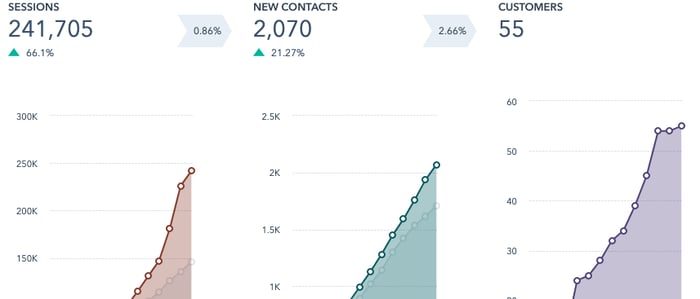
20 Important Metrics for Revenue Operations Analysts
Sabrina Colonna
“You can’t improve what you don’t measure.”
This statement, often attributed to Peter Drucker, perfectly captures why revenue operations analysts (and RevOps in general) are important today.
Brands are increasingly looking at Marketing, Sales, and Service as one entity with shared tools, processes, and goals.
By measuring every touchpoint affecting the customer experience, companies have a unique opportunity to increase efficiency, remove friction, and ultimately maximize revenue. Figuring out what to measure is the only way to hold teams accountable and make sure your revenue operations strategy is on track.
How Do You Measure Revenue Operations?
KPIs for revenue operations enter around the quantity, velocity, or conversion rate of various data points. These metrics begin with the prospecting or lead generation processes, and end when the customer lifecycle is complete.
Here are some foundational metrics revenue operations analysts should consider measuring and reporting on:
Marketing KPIs For RevOps
1. Website Traffic
The number of visits the website gets is a good starting metric for your company’s digital marketing strategy. As you gain an understanding of your average conversion rates, changes in site traffic will help you forecast the volume of leads entering the sales pipeline.
2. Session-to-Contact Rate

Session-to-contact rate measures new contacts created from website sessions in a given period of time.
Most websites average between a 0.20 to 1 percent rate. Well optimized websites with high conversion rates can sometimes reach 2 percent or higher.
3. Lead Volume
Establishing how many leads are needed to meet a revenue objective is one of the most critical metrics to measure in any company growth strategy.
From that point forward, the RevOps team should focus on improving efficiencies to reduce the number of leads required while also making sure the pipeline is consistently full.
4. Qualified Lead Volume
How many inbound leads match your organization’s ideal customer profile?
Your ICP should spell out which company attributes make a great fit for your products and services. Once your ICP is in place, measuring the volume of qualified leads will give you a sense of how well your demand generation campaigns are performing.
Related Content: What Is Revenue Operations (RevOps)?
5. Lead-to-Customer Conversion Rate
The lead-to-customer shows you how many total leads end up signing up as customers. It’s not unusual to see roughly five-percent of total leads (qualified and unqualified together) convert into customers.
6. Cost-per-Lead

As Marketing hones the lead generation strategy and focuses resources on the highest performing channels, cost-per-lead should go down while the percentage of qualified leads goes up.
7. Cost-per-Acquisition
As the cost-per-lead improves, your company should also see acquisition rates increase and costs decrease. Keeping these metrics moving in the right direction takes sustained effort and focus over the long term, but it’s more than worthwhile.
Sales KPIs For Revenue Operations

8. Employee Onboarding Ramp Time
Onboarding may not be the first thing that comes to mind when you think of revenue operations, but reducing the length of time it takes to get new employees up to a productive level is more than a time saver for the management team.
It's also a great way to avoid unnecessary friction with customers and ensure sales metrics remain on track.
9. Number of Touches Before Connecting
Knowing how many touches it takes before a sales rep connects with a prospect gives the RevOps team insight into how effective the outreach process is.
You may also find value in measuring the results with inbound and outbound leads separately, as well as which tactics help reps connect the fastest.
10. Number of Touches Before a Demo
After a connection is made, it’s useful to know how many touches it takes before a buyer is ready to see a demo or a proposal.
This will help you understand the buyer’s journey on a deeper level while monitoring the effectiveness of your sales process.
11. Number of Touches Before Closing New Business

How many meetings, phone calls, and emails does it take before a prospect moves into the “closed won” column?
How can you address buyer concerns earlier in the process? Measuring the number of touches before closing new business will help you find hurdles that are slowing down the pace of growth.
12. Closing Rate
Sales and RevOps managers should always know the average closing rate for new clients.
More than anything else, this foundational metric will give you clarity into overall sales performance, and the strengths or weaknesses of individual team members.
13. Deal Size
The average value of deals is another easily missed KPI that can have an enormous impact on your company’s bottom line.
There are only so many opportunities a sales team can work on at any given time. Increasing the deal size by focusing on qualified leads that have the greatest needs and resources can vastly improve revenue operations.
14. Number of Deals
If deal value is difficult to grow, a good alternative is to explore ways to increase the volume of deals.
If the team is able to improve closing rates and deal volume at the same time, your organization will see a lot of positive growth.
15. Velocity of Deals

How fast are deals moving through the pipeline? It’s not uncommon for deals that once looked promising to get stuck for months or even years.
Measuring the velocity of deals may help you find insights into why some deals take longer to close than others and find creative solutions to overcome them.
16. Client Onboarding Ramp Up
You might be surprised by how many clients experience buyer’s remorse during the onboarding process itself.
Just as speeding up employee onboarding can help revenue operations run smoothly, client onboarding is a critical piece to get right. Organizations that track how long it takes to onboard clients and start the engagement on the right foot are much better positioned for long term growth.
"How can you address buyer concerns earlier in the process? Measuring the number of touches before closing new business will help you find hurdles that slow down the pace of growth."
Service KPIs for Revenue Operations

17. Cross Selling & Upselling Rate
Client needs change and evolve on a continuing basis, and it’s important to track how often service teams solve these needs by cross-selling or upselling services.
If your brand offerings are well aligned with specific buyer challenges, these opportunities won’t feel like “selling” as much as simply helping customers be more successful.
18. Churn Rate
A high churn rate is public enemy number one when it comes to sustained growth.
When you factor in all the time and money it takes to bring in new business, client retention is the most important aspects of revenue operations. Identifying and removing points of friction that lead to churn should be a strong focus for all teams in the organization.
19. Lifetime Value
Maximizing customer lifetime value helps both the company and the customer get the most out of the relationship.
The longer a customer stays with you, the more opportunities your brand has to adapt to new challenges, learn about industry trends, and provide new solutions to them. Increasing the lifetime value will help you get the greatest ROI for the cost of acquiring the customer.
20. Profit Margin
Last but not least, profit margin is a key metric for determining which products or services add greatest benefit to the balance sheet. They also typically require the fewest human and capital resources, which reduces stress on your company.
These 20 KPIs are by no means a comprehensive list of metrics -- there is never a shortage of processes and results to measure -- but it's a good start for any company making a serious effort toward maximizing revenue operations across all departments.
The sooner you can find and monitor the arteries that give life to your organization, the sooner you can ensure they are all in good health.
Jun 23, 2022 2:31:33 PM


